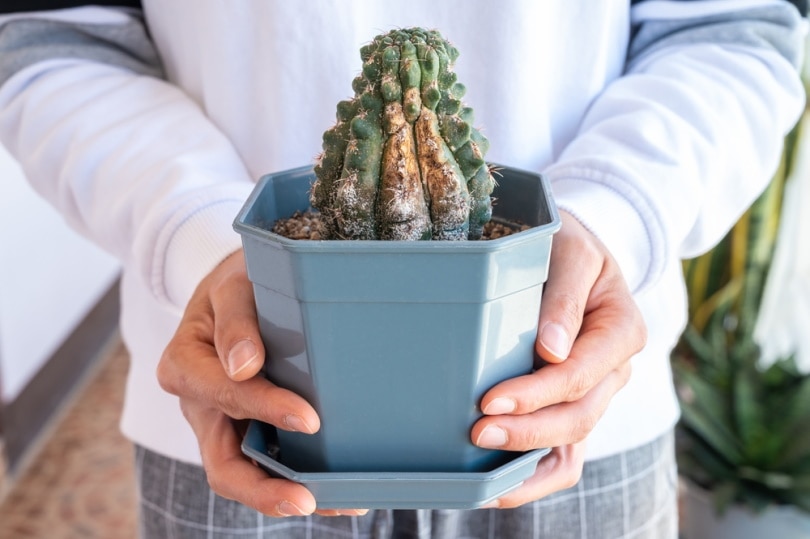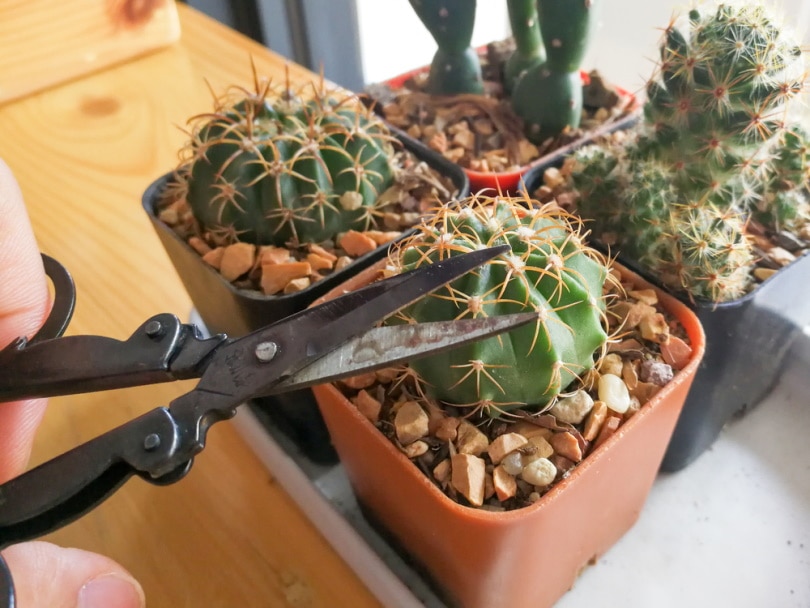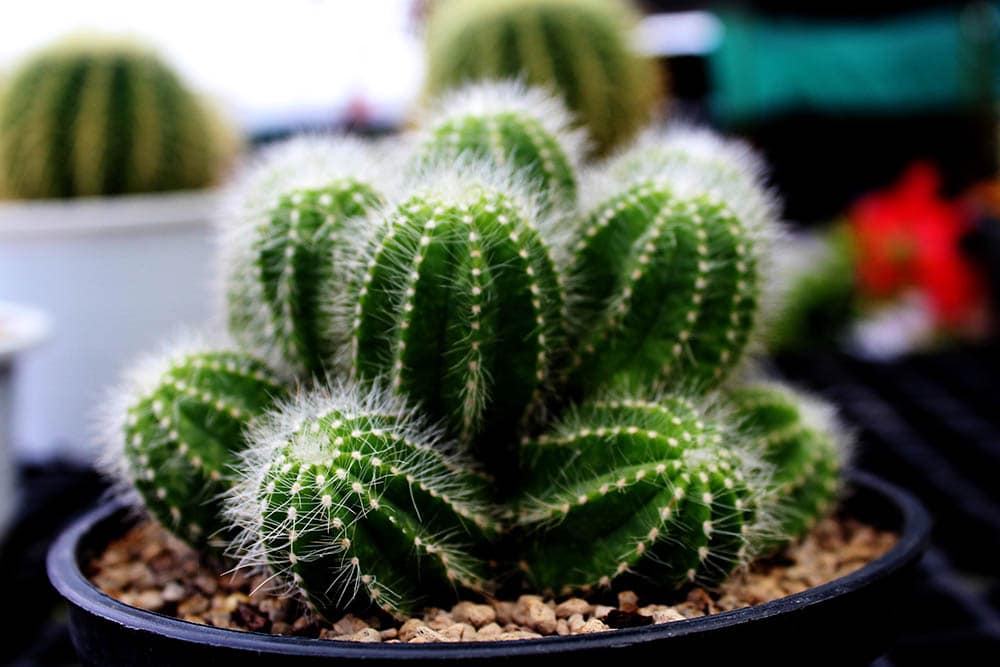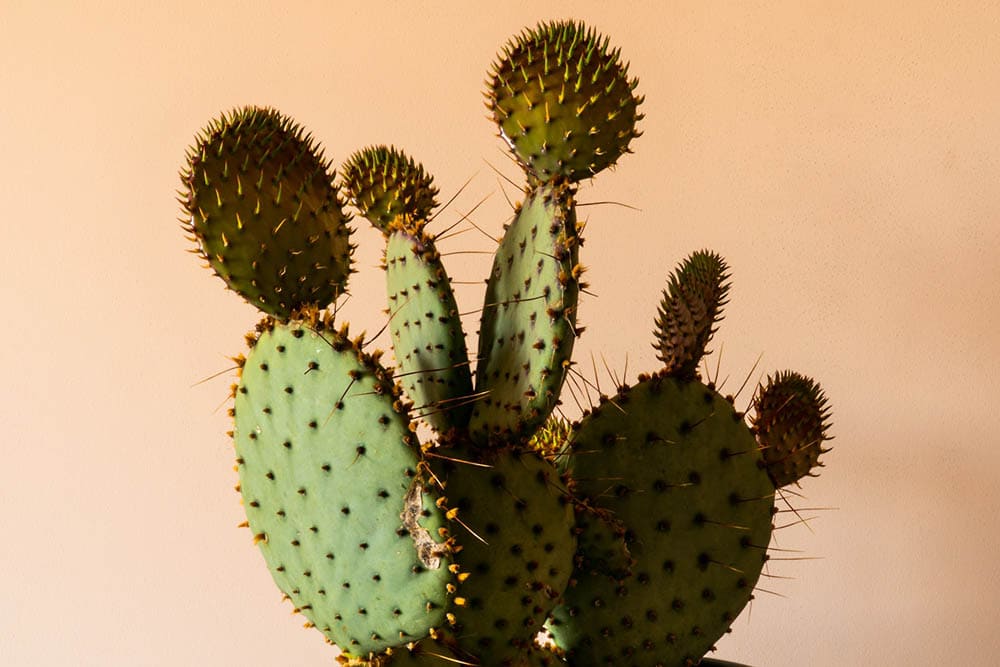How Do Cacti Reproduce? Parts, Varieties, & FAQ
-
Ashley Bates
- Last updated:

If you’re a plant lover, you probably enjoy checking out the cactuses in the garden section. Even though you admire their versatility and beauty, you might not understand just how these plants form.
If you’ve never started a cactus from a seed, we’re here to tell you a little bit about how they reproduce and grow in nature. Also, we will tell you how to get started with a cactus of your very own.
 What Is a Cactus Anyway?
What Is a Cactus Anyway?
A cactus is a type of perennial succulent that thrives in arid and scorching climates. These flowering plants come in many sizes and shapes—beautiful to behold. You can see them in southern states and other countries across the globe.

All Cacti Reproduce
Something exciting you might not know about cactuses is that they all can reproduce by themselves. These asexual plants have both male and female parts, able to deal with reproduction in a solo fashion
completely.
These plants are incredibly unique, coming in all shapes and sizes. They will impress with their floral blossoms and odd growths. In practice, reproduction is generally the same across the board, even though they look drastically different.
Now, let’s look at the asexual reproduction of these unique spiky plants.
How Do Cacti Reproduce?
Cactuses have a fascinating reproductive process. They can reproduce by seed, layering, and re-sprouting from loose pieces. If you take a segment off your cactus and plant it into the soil, within a few weeks it will route and regrow.
This makes it very popular among plant keepers because they typically are effortless to keep alive, and you can take starts off of them to create new plants anytime you have a healthy structure.
Seeding
Seeding is probably exactly what it sounds like when a cactus flowers and the flower withers, the seeds inside will distribute onto the ground to create new growth.
These seeds germinate and grow. But many cactus seeds develop very slowly. So, it might be a while before you can fully enjoy the beauty of the plant.
Fragmentation
Fragmentation is the process by which you can remove a cactus segment and plant it in new soil. It won’t take long before this segment roots itself and regenerates. A cactus is definitely adequate in reproduction and can thrive even under desolate circumstances.

Starting Cacti from Seed
Starting a cactus from seedlings can be extremely challenging at first, especially if you’re inexperienced. However, with a bit of time and patience, you can quickly grow these beautiful plants from seeds, turning them into majestic and gorgeous full-sized plans. Cacti love humidity and dry soil. So, when the babies are very young, it is essential to create the right environment so they can thrive accordingly.
Initially, seedlings like to be in somewhat moist soil but not damp. It is imperative to provide adequate moisture and prevent oversaturating the soil. There are different methods to start seedlings. Some people use plastic zip lock bags to begin as they trap moisture and exemplify heat.
In the beginning, you will want to make the right combination of soil grit to create the best environment for cactus growth. These items include para light coarse sand, peat moss, and coco coir. This video lets you get complete details on how the process works.
If you’re propagating from seeds, it can be more challenging since it requires time and patience. If you want to take from existing plants that you already have instead of purchasing seeds, you’ll have to wait for your cactus to flower, wither, and then you need to collect them.
Propagating Cacti from Cuts

Propagation is the most common in seed form, as it is a natural process by which the cactus flowers seeds and roots. However, among growers at home, propagating by stem cuttings is probably the most popular decision.
You can propagate your cactus successfully from the plants that you already have. You simply remove the cactus at a crook or individual segment point. You take off the growth piece and gently place it into the soil.
Once the segment roots itself, you’re going to start watching new growths form from the segment.
You don’t have to cover it up with soil, but just make sure that the base of the cutting is connected to the ground. With adequate watering and care, you should start to see new routing within the first few weeks.
Learning the Parts of a Cactus
A cactus differs from other plants in structure and growth period they are incredibly interesting in their own right, and it can be a little challenging to learn how each individual system in your cactus functions. Here are some components of your cactus and the functions that they are responsible for.
Roots
A cactus typically has shallow roots that absorb water and nutrients, drawing it into this succulent vascular tissue in the stem and trunk. The roots generally are not extremely deep or prevalent. They just simply serve as a straw source to suck up the nutrients and water into the trunk itself where it is stored. The water is then evenly distributed throughout the growth nodes to distribute the nutrients.
Root systems can look very different depending on the cactus species you’re looking at. Some root systems may be fleshy and thick, while others are shallow, thin, and corklike. All roots have absorbent hairs on the outside that shed much like our body cells, regenerating with new and healthy growth.
Thorns

All cacti have thorns, and you might think it’s to ward off predators. While this is perfectly true, these prickles help them from attack, preventing them from being lunch for an herbivore. However, these adaptations also help the cactus thrive in its environment because they protect the skin’s outer portions from bright sun and arid temperatures.
Cuticle
The cuticle is a thick, waxy substance on the outside of plants to protect them from the environment.
Cactus Varieties
Cactus varieties are plentiful. It just depends on the type of cactus that you have and the growth environment that it lives in. You can find different variations everywhere you look. Some cactuses, at their largest, are still very tiny, while other ones are larger than you.
- Mammillaria
- Astrophytum myriostigma
- Echinocereus
- Strawberry hedgehog
- Beavertail
- Kingcup
- Parodia scopa
- Escobaria vivipara
- Echinocereus fendleri
- Texas prickly pear
- Lace hedgehog
- Eriosyce seniis
- Rebutia helios
- Turk’s head
- Cholla
There are plenty more, but we’re not going to get into those here. The list would be virtually never-ending.
Cacti are so unique in their formation and growth that any plant lover can admire them. They are considered a type of succulent in a world all their own. But if we want to get specific, there are over 2000 species of cactus with 139 particular genera.
 Final Thoughts
Final Thoughts
So now you know that cacti are completely asexual plants that are more than capable of reproducing as a solo structure. You can quickly grow cactus from seeds or propagation from cuttings. The choice is really yours.
Once you have healthy plants started, it’s typically very easy to keep them healthy, permitting you’re giving them the correct type of environment. Are you a cactus fan? Let us know which species of cactus is your favorite.
Featured Image Credit: Boyloso, Shutterstock
Contents
 What Is a Cactus Anyway?
What Is a Cactus Anyway?
